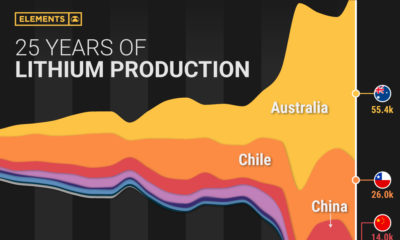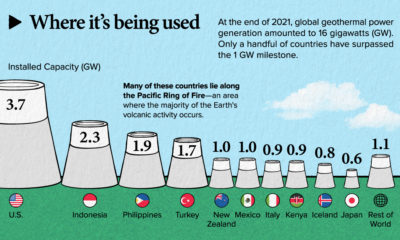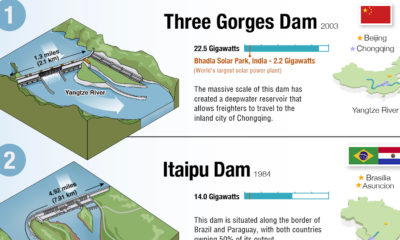Today’s infographic from Raconteur breaks down the material shift towards renewable energy, and where in the world it’s taking place.
Time to go green
A recent United Nations report estimates that renewables must make up 70% to 85% of electricity by 2050 to combat the dire effects of climate change. The good news? Embracing renewable energy is becoming easier on the wallet. Most renewable energy sources are becoming cheaper and quicker to produce, and it’s speeding up widespread adoption. The price of solar photovoltaic cells are projected to dip dramatically over this seven-year period, as solar panel infrastructure moves away from being an experimental technology, and into a trusted energy source easily replicated at scale. Solar also received the most new investment by energy type in 2017, up 18% from the previous year. Of course, it won’t happen overnight. Even as the world continues to electrify, coal will still make up almost one-third of the world’s energy mix in 2040, while renewables will only be at 25%. Nevertheless, concentrated efforts to curb our reliance on coal are signals that the fossil fuel is on its way out, and new investment in green energy sources is on the rise in most regions.
The Renewables Race
It’s perhaps not surprising that China is leading the change in renewable growth. The nation tops the list of spenders, spending more on green energy than the United States and Europe combined. In places where a consistent and reliable source of energy is hard to come by, people are looking to clean energy as a way to leapfrog ahead of using the carbon-intensive electricity grid entirely. Take Ethiopia for example: the $4 billion Grand Ethiopian Renaissance Dam (GERD) project along the Nile River will help meet the area’s rising energy demands. Once completed, it will be the largest dam on the continent and generate around 6,450 MW of power. This trifecta of innovation, investment, and falling costs could be the answer to bolstering renewable energy infrastructure for decades to come – and it will be interesting to see the ultimate pace at which green energy supply comes online, and what that means for the world. on Over recent decades, farmers have been able to more than double their production of crops thanks to fertilizers and the vital nutrients they contain. When crops are harvested, the essential nutrients are taken away with them to the dining table, resulting in the depletion of these nutrients in the soil. To replenish these nutrients, fertilizers are needed, and the cycle continues. The above infographic by Brazil Potash shows the role that each macronutrient plays in growing healthy, high-yielding crops.
Food for Growth
Nitrogen, phosphorus, and potassium (NPK) are three primary macronutrients that are the building blocks of the global fertilizer industry. Each plays a key role in plant nutrition and promoting crop growth with higher yields. Let’s take a look at how each macronutrient affects plant growth. If crops lack NPK macronutrients, they become vulnerable to various stresses caused by weather conditions, pests, and diseases. Therefore, it is crucial to maintain a balance of all three macronutrients for the production of healthy, high-yielding crops.
The Importance of Fertilizers
Humans identified the importance of using fertilizers, such as manure, to nourish crops dating back to nearly 6,000 to 2,400 BC. As agriculture became more intensive and large-scale, farmers began to experiment with different types of fertilizers. Today advanced chemical fertilizers are used across the globe to enhance global crop production. There are a myriad of factors that affect soil type, and so the farmable land must have a healthy balance of all three macronutrients to support high-yielding, healthy crops. Consequently, arable land around the world varies in the amount and type of fertilizer it needs. Fertilizers play an integral role in strengthening food security, and a supply of locally available fertilizer is needed in supporting global food systems in an ever-growing world. Brazil is one of the largest exporters of agricultural goods in the world. However, the country is vulnerable as it relies on importing more than 95% of its potash to support crop growth. Brazil Potash is developing a new potash project in Brazil to ensure a stable domestic source of this nutrient-rich fertilizer critical for global food security. Click here to learn more about fertilizer and food production in Brazil.































